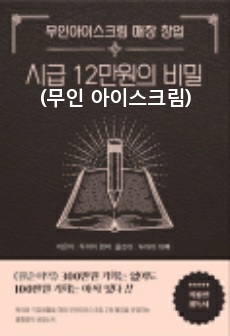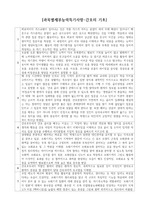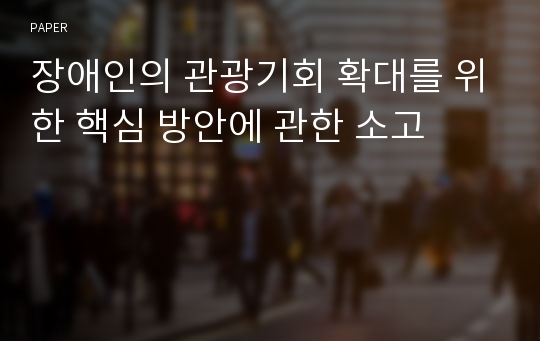장애인의 관광기회 확대를 위한 핵심 방안에 관한 소고
*구광역시장애인재활협*
다운로드
장바구니
목차
Ⅰ. 서론Ⅱ. 선행연구 고찰
1. 장애인 관광권에 대한 국내외적 관심
2. 장애인 관광에 대한 선행 연구
III. 장애인관광 활성화 방안
1. 장애물 없는 관광 환경 조성
2. 관광정보에 대한 접근성 제고
3. 관광기업 종사자에 대한 교육‧훈련
4. 정부의 정책적 지원
III. 결론
본문내용
Ⅰ. 서론21세기 관광현상과 관련한 핵심 화두 중 하나로 사회적 정의(social justice) (Cohen & Cohen, 2012)가 부상함에 따라 사회적 소외계층에 대한 담론, 특히 장애인‧노인‧저소득층 등 사회적 소외계층의 관광권 향상에 대한 관심이 증가하고 있다. 그동안 장애인은 경제적 어려움 뿐 아니라 자신이 가진 신체적‧인지적‧정서적 형태의 장애로 인해 관광환경에서 비가시적(invisible)인 특성을 보여 왔음을 고려할 때 상기와 같은 현상은 매우 고무
적인 일이다 할 것이다.
한편 상기한 현상 대두에는 많은 요인들이 영향을 미쳤는데, 무엇보다도 세계 각국에서 제정된 장애인 권리 관련 법[예: Americans with Disabilities Act(1990, 미국), Disability Discrimination Act(1992, 호주), Equality Act(2010,영국), 장애인‧노인‧임산부 등의 편의증진 보장에 관한 법률(1999, 한국), 장애인차별금지 및 권리구제 등에 관한 법률(2008. 4. 한국)]을 들 수 있다.
두 번째는 관광환경에의 접근성(accessibility) 향상과 장애인 관광권(rights to travel)에 대한 국제적 인식 확산(UNWTO, 2003; UNESCAP, 2000)을 들수 있다. 특히‘UN 장애인 권리에 관한 조약(Convention on the Rights of Persons with Disabilities)’을 UN 회의에서 채택하고 각국이 이를 비준함 으로써 장애인의 관광을 포함한 문화 관련 기본욕구를 적절하게 충족시키는 것의 중요성에 대한 인식은 확대되었다(Darcy & Pegg, 2011). 동 조약 제30조는 관광을 포함한 모든 문화 영역에의 접근권을 강조하고 있으며, 또한 각국 정부 혹은 관광기업들로 하여금 장애인들의 관광상품 및 서비스에의 접근성을 보장하도록 관리‧운영에 있어서의 변화를 꾀할 것을 공식적으로 요구하는 조항이라 하겠다. 세 번째는 장애인 관광시장의 잠재력에 대한 인식 증가와 함께(Ray & Ryder, 2003) 장애인관광 관련 다양한 주제에 대한 연구가 활발히 수행되어져 왔다는 점이다
참고 자료
박종희․박경일․최정자(2004). 장애인의 관광 참여 동기와 장애에 관한 탐색적 조사. 제55차 한국관광학회 학술논문발표대회논문집 (pp.181-194).
이봉구(2008). 관광 관련 제약요인이 장애인의 관광 참여 의도에 미치는 영
향에 관한 연구: Seligman의 무력감이론의 적용. 관광학연구,32(2), 39-59.
이봉구(2011). 장애유형별 관광지 및 관광정보 관련 속성에 대한 만족 차이와 각 속성에 대한 만족이 전반적 만족에 미치는 영향 차이:
Matzler와 Sauerwein의 삼(三) 요인 만족 모델의 적용. 관광학연구, 35(5), 55-80.
이봉구(2012). Understanding differences in travel information requirements
across disability types and implications for developing accessible tourism information schemes. 관광연구논총, 24, 3-32.
봉구(2013). 장애인관광시장에 대한 우리나라 관광업계의 인식 및 준비 실태에 관한 연구. 관광학연구, 37(7), 55-76.
이봉구(2014). 여행경력에 따른 장애인의 의사결정에 있어 관광동기의 역할차이 고찰. 관광학연구, 38(5), 229-252.
이훈․이영진(2010). 후천적 장애인의 관광활동 단계 및 장애유형에 따른 제약과만족 분석. 중복․지체부자유연구, 53(1), 263-287.
한국관광공사(2014). 장애물 없는 관광환경 조성을 위한 실태조사 및 개선방안.
Abeyraine, R. I.(1995). Proposals and guidelines for the carriage of elderly and disabled persons by air. Journal of Travel Research,33(3), 52-59.
Bi, Y., Card, J. A., & Cole, S. T. (2007). Accessibility and attitudinal barriers encountered by Chinese travellers with physical disabilities.
International Journal of Tourism Research, 9, 205–216.
Burnett, J. J. & Baker, H. B.(2001). Assessing the travel related behaviors of the mobility-disabled consumer. Journal of Travel Research, 40, 4-11.
Buhalis, D., Michopoulou, E., Eichhorn, V., & Miller, G.(2005). Accessibility market and stakeholder analysis: One-stop-shop for accessible tourism in Europe (OSSATE). Surrey, United Kingdom: University of Surrey.
Card, J. A., Cole, S. T., & Humphrey, A. H.(2006). A comparison of the accessibility and attitudinal barriers model: Travel providers and travelers with physical disabilities. Asia Pacific Journal of Tourism Research, 11(2), 161-175.
Cavinato, J. L., & Cuckovich, M. L.(1992). Transportation and tourism for the disabled: An assessment. Transportation Journal, 31(3), 46-53.
Cohen, E., & Cohen, S. A.(2012). Current sociological theories and issues in tourism. Annals of Tourism Research, 39(4), 2177-2202.
Daniels, M. J., Rodgers, E. D., & Wiggins, B. P.(2005). "Travel tales": An interpretive analysis of constraints and negotiations to pleasure travel as experienced by persons with physical disabilities.
Tourism Management, 26(6), 919-930.
Darcy, S.(2010). Inherent complexity: disability, accessible tourism and accommodation information preferences. Tourism Management, 31(6), 816-826.
Darcy, S., & Buhalis, D.(2011). Introduction: From disabled tourists to accessible tourism. In D. Buhalis & S. Darcy(eds.), Accessible
tourism: Concepts and issues(pp. 1-20). Bristol, UK: Channel View Publication.
Darcy, S., & Pegg, S.(2011). Towards strategic intent: perceptions of disability service provision amongst hotel accommodation managers. International Journal of Hospitality Management, 30, 468-476.
O'Neill, M., & Knight, J.(2000). Disability tourism dollars in Western Australia hotels. Hospitality Review, 18(2), 72-88.
Dwyer, L., & Darcy, S.(2008). Economic contribution of disability to tourism in Australia. In S. Darcy, B. Cameron, L. Dwyer, T.Taylor, E. Wong & A. Thomson (Eds.), Technical Report 90040: Visitor accessibility in urban centers (pp. 15–1). Gold
Coast: Sustainable Tourism Cooperative Research Centre.
Eichhorn, V., Miller, G., Michopoulou, E., & Buhalis, D.(2008). Enabling access to tourism through information schemes? Annals of Tourism Research, 35(1), 189-210.
ENAT(2009). UK tourism firms encouraged to improve accessibility.
Retrieved 26 December, 2010, from http://www.accessibletourism.org/?i=enat.en.news. 713.
Grady, J., & Ohlin, J. B.(2009). Equal access to hospitality services for guests with mobility impairments under the Americans with Disabilities Act: Implications for the hospitality industry.
International Journal of Hospitality Management, 28(1), 161-169.
Gutierrez, C. F., Loucopoulos, C., & Reinsch, R. W.(2005). Disability-accessibility of
airlines’ Web sites for US reservations online. Journal of Air Transport Management, 11, 239–247.
Israeli, A. A.(2002). A preliminary investigation of the importance of site accessibility factors for disabled tourists. Journal of Travel Research, 41(1), 101-104.
McGrath, R.(2009). A discourse analysis of Australian local government
recreation and sport plans provision for people with disabilities. Public Management Review, 11(4), 477-497.
McKercher, B., Packer, T., Yau, M. K., & Lam, P.(2003). Travel agents as facilitators or inhibitors of travel: Perceptions of people withdisabilities. Tourism Management, 24, 465-474.
Mills, J. E., Han, J., & Clay, J. M.(2008). Accessibility of hospitality and tourism websites: A challenge for visually impaired persons. Cornell Hospitality Quarterly, 49(1), 28-41.
Neumann, P., & Reuber, P.(2004). Economic impulses of accessible tourism for all (vol. 526), Berlin: Study commissioned by the Federal Ministry of Economics and Technology & Federal Ministry of Economic and Labour (BMWA).
Ozturk, Y., Yayli, A ., & Yesiltas, M.(2008). Is the Turkish tourism industry ready for a disabled customer’s market? The views of hotel and travel agency managers. Tourism
Management, 29, 382–389.
Packer, T. L., McKercher, B., & Yau, M. K.(2007). Understanding the complex interplay between tourism, disability and environmental contexts. Disability & Rehabilitation, 29(4), 281–292.
Qi, S., Law, R., & Buhalis, D.(2008). Usability of Chinese destination management organization websites', Journal of Travel & Tourism Marketing, 25(2), 182– 198.
Ray, N. M., & Ryder, M. E.(2003). ‘'Ebilities’' tourism: An exploratory discussion of the travel needs and motivations of the mobility disabled. Tourism Management, 24(1), 57-72.
Rice, P.(2006). Universal management: a proposal to change the direction of accessibility management in the Australian tourism industry to create benefits for all Australians and visitors to Australia. The Review of Disability Studies: An International
Journal, 2(2), 64–69.
Shaw, G., & Coles, T.(2004). Disability, holiday making and the tourism industry in the U.K.: A preliminary survey. Tourism Management, 25, 397-403.
Small, J., Harris, C., & Wilson, E.(2008). A critical discourse analysis of in-flight magazine advertisements: The 'social sorting' of airline travelers?. Journal of Tourism and Cultural Change, 6(1), 17-38.
Smith, R. W.(1987). Leisure of disabled tourists: Barriers to travel. Annals of Tourism Research, 14(3), 376-389.
Takeda K., & Card, J. A.(2002). US tour operators and travel agencies.
Journal of Travel & Tourism Marketing, 12(1), 47-61.
Turco, D.M., Stumbo, N., & Garncarz, J.(1998). Tourism constraints for people with disabilities. Parks and Recreations, 33(9), 78-84.
UNWTO(2003). Barrier-free tourism for people with disabilities in the Asian and Pacific region. NY: United Nations.
UNESCAP(2000). Conditions to promote barrier-free tourism for people with disabilities and older persons. Economic and Social Commission for Asia and the Pacific(ESCAP). Presentation at the National Workshop on Sustainable Tourism Development in China, Tianjin, China.
Westcott, J.(2004). Improving information on accessible tourism for disabled people. The European Commission.
Williams, R., Rattray, R., & Grimes, A.(2006). Meeting the on-line needs of disabled tourists: An assessment of UK-based hotel websites.
International Journal of Tourism Research, 8, 59–73.
Yau, M. K., McKercher, B., & Packer, T. L.(2004). Traveling with a disability more than an access issue. Annals of Tourism Research, 31(4), 946-960.
w w w . n e w s i s . c o m / a r _ d e t a i l / v i e w . h t m l ? a r _ i d = N I S X 2 0 1 5 0 4 1 7 _0013606629&cID=10201&pID=10200www.welfarenews.net/news/articleView.html?idxno=50475




























